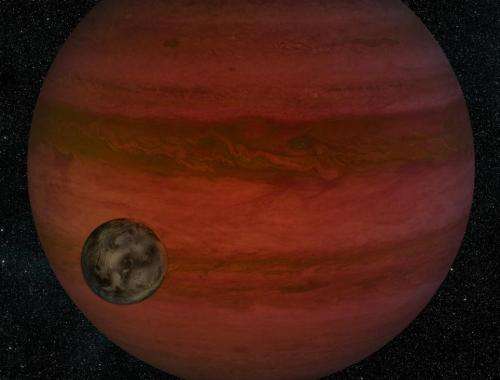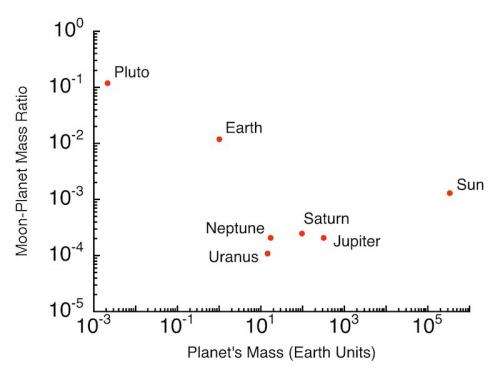Lunar prospecting: Scanning the skies for moons in other solar systems

The first exoplanet was discovered in 1994. Twenty years later, NASA's exoplanet catalog lists more than 1700 planets confirmed around other stars. Most of these extra-solar-systems have been measured by changes in light spectra, in stellar motion or dust disks around stars. Some exoplanets-more than 40 as of today-have even been directly photographed. One way or the other, we know that exoplanets are out there in abundance, in places we thought they would be and in places we didn't dream a planet could possibly exist. So what comes next?
We find their moons, of course.
Exomoons are naturally formed satellites circling around planets in other solar systems. Like the exoplanets themselves, we assume that exomoons are out there in relatively high abundance. This assumption is based partly upon what we see around us in our own Solar System and partly upon our hypotheses about planetary formation.
This is what we observe in our own Solar System: moons are extremely common. From Earth's one Moon to Jupiter's (currently known) fifty, every planet in the Solar System one astronomical unit or more from the Sun has a natural satellite. Even Pluto, no longer officially classified as a planet, has a smaller companion circling around it.
Of note, the solid bodies such as Earth and Pluto have very few companions, while gaseous bodies Jupiter, Saturn, Uranus and Neptune have many. Furthermore, the masses of the Moon and Charon have a very specific relationship to Earth and Pluto in terms of mass: each satellite is about 10-2 the mass of their parent planet. By contrast, the ratio of satellite masses to parent planet masses for the gas giants is very different: 10-4.
The differences in mass-ratio - how massive the moon is compared to the parent planet - and the differences in composition between the moons of solid planets and those of the gas giants led to a search for different formation scenarios for Earth's moon and the moons of the outer planets.
This is the current hypothesis: that there are two different methods of satellite formation at work in our Solar System. Both methods were recently reviewed by Dr. Amy Barr Mlinar of Brown University at the Space Telescope Science institute Spring Symposium.
"This has been worked out starting about in the 1960's up through now," said Barr, "You have this [moon/planet] mass ratio of about 10-2 for solid planets, and a [moon/planet] mass ratio of about 10-4 for planets with a gaseous envelope."
Essentially, difference in mass ratios reflects the two completely different origins of our Moon and the satellites of Jupiter.
At the high end of the moon/planet mass ratio, 10-2 are the satellites of solid bodies (Earth and Pluto). These moons were formed from collisions. Sometime in the distant past an object some large percentage of Earth's size struck the Earth, knocking material away that later coalesced into the Moon. The same is likely true of Charon, Pluto's companion.

For the gas giants, a totally different satellite-forming process lead to moon/planet mass ratios on the order of 10-4. Rather than being born from collisions, the satellites of gas giants co-accreted or grew from the same spinning disk of dust and gas as their parent planets. As a result, the gas giants and their moons resemble mini solar-systems, with large collections of moons rotating in roughly the same plane and in the same direction as their parent planets-with a few notable exceptions. Even the moons that don't conform precisely to patterns of orbit and plane, like Neptune's moon Triton, still conform to the 10-4 moon mass/mass planet ratio.
"There is a maximum satellite mass in this [kind of] system, and it's governed by how long it takes to build a body [out of the dust disk]," said Barr.
The moon:planet mass ratios explain our own Solar System and give us guidance for exploring other distant solar systems. Based on these models, we can look at the exoplanets we are finding and, depending on whether they are gaseous or rocky, begin searching for moons that formed by either co-accretion or collision. Given these models, we have the ability to estimate what the mass of the exomoons should be and where they should be orbiting.
The problem is that we lack the astronomical firepower to go looking for them-at least, for the moment.
At present our planet-hunting workhorse, the Kepler satellite, can only find exoplanets or exomoons above a certain size. That size is twenty percent of the mass of the Earth. For many, a body ten percent of the Earth qualifies as a planet in its own right. Mars, for example, is ten percent of the mass of the Earth.
"It is the opinion of the Hunt for exomoons with Kepler team that you can't make [a moon that size] by any process that operated in our solar system," said Barr.
Using the model we have for the Moon, to get a satellite 20% the mass of Earth around a solid planet, a 20-Earth-mass planet would have to exist. Our current models predict that if a planet that size had formed in our Solar System it would have had enough gravity to accrete gas.
In other words, we don't know a way to form an Earth-like planet with a moon we can find given today's technology. The result wouldn't be an Earth-moon system-it would be some sort of binary planetary system.
"The other option is that if you want to make [an exomoon big enough to been seen by Kepler] is by co-accretion," said Barr, "[for which] You need a [gasous] exoplanet that is about 10-15 times the mass of Jupiter."
At that point, other problems arise. The most notable of these is that many of the large exoplanets we're finding are extremely close to their stars-so close that any moons of those exoplanets would have been pulled from their parent planets by their star's gravity, or torn apart.
According to Barr, our best bet for locating a habitable moons among the stars may be to wait for the next generation of satellites-ones that will allow us to find exomoons the sized of Ganymede.
"And I think these bodies [Ganymede-sized exomoons] could be habitable," said Barr.
Habitability in this case refers to the presence of liquid water. According to Barr, we have direct evidence of liquid water on at least five moons in the Solar System: Europa, Ganymede, Enceladus, Callisto and Titan. Europa-like bodies like Enceladus and even Pluto are believed to have water directly in contact with rock, which increases inhabitability.
"Obviously this is much more exciting to [astrobiologists] because you can do interesting water-rock chemistry at the [rock-water interface]," said Barr.
Water-rock chemistry might or might not be happening on any exomoon that Kepler is capable of finding. Those exomoons, with masses greater than 20% the mass of the Earth, are bodies that we know nothing about by either observation or hypothesis. According to Barr, we have never even modeled anything like that.
In the hunt for life in the Universe, exomoons are a worthy target. Given how much water is available on the icy moons of our own solar system, the volume of water on icy exomoons around exoplanets could substantially increase the habitability of the Galaxy. Our prospects for striking exo-lunar gold will depend not only on the next generation of telescopes, but also on a new generation of computer models to help us understand where to look.
"If the hunt for exomoons with Kepler finds something it may have been created by processes that we view as exotic and weird," said Barr, "while we're waiting for the next generation [of planet-hunting satellites, there are things that we can do to help move the theory forward. We have to branch out."
Source: Astrobio.net













.jpg)






